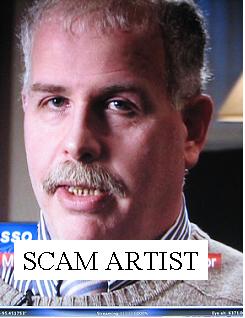Provide by the American Associtation of Retired Persons
Washington, D.C.
How to Spot a Con Artist
Paraphrased and edited to accommodate the unique personality of the Carteret Con Artist, our one and only Joe Cafasso.
The clever con artist is a good actor who disarms his victims with an affable 'nice guy' approach. Most people who have met Cafasso say that is how he comes across to begin with, it is only later on, when people have caught onto his game, that he becomes a nasty vicious and physically violent psycho.
Behind his initially friendly exterior, Cafasso is a shrewd psychologist who isolates potential victims and breaks down their resistance to his proposals. Each conquest is a part of a game in which he must 'best' his fellow man or in a lot of cases, woman. Cafasso, like the typical con artist, is amoral, with an excellent sense of timing. He believes that his victims deserve their fate. If caught, he'll probably strike again later. Con artists are seldom rehabilitated.
The Victim
Anyone can be a victim-even a person who considers himself too intelligent or sophisticated to be 'conned'. During the 1920's, "Yellow Kid" Weil routinely swindled bankers, saying 'That's where the money is." Many victims share certain characteristics. Often but not always, they are older, female, and live alone. Cafasso has succeeded in illustrating that point, time and again. They are trusting of others - even strangers - and may need or desire supplemental income. This explains how he ingratiates himself to married women, and promises them work, when he hasn't had a job himself for a very long time. Unless you include his 'humanitarian efforts', which seem to be disguise for something else.
Loneliness, willingness to help, and a sense of charity are characteristics a con artist will exploit to gain a victim's cooperation.
The con artist ultimately will exploit his victim's assets - including life insurance benefits, pensions or annuities, 'nest eggs', home equity, or other tangible property. And he'll usually obtain the willing cooperation of his victim to complete his scheme.
Key Words
A con artist is difficult to detect by looks alone. But you can often spot him by his words or expressions, including:
- CASH ONLY
- Why is cash necessary for a proposed transaction? Why not a check?
- SECRET PLANS
- Why are you being asked not to tell anyone?
- GET RICH QUICK
- Any scheme should be carefully investigated.
- SOMETHING FOR NOTHING
- A 'retired' swindler once said that any time you are promised something for nothing, you usually get nothing.
- CONTESTS
- Make sure they aren't a 'come-on' to draw you into a money-losing scheme.
- HASTE
- Be wary of any pressure that you must act immediately or lose out.
- TODAY ONLY
- If something is worthwhile today, it's likely to be available tomorrow.
- TOO GOOD TO BE TRUE
- Such a scheme is probably not good or true.
- LAST CHANCE
- If it's a chance worth taking, why is it offered on such short notice?
- LEFT-OVER MATERIAL
- Left-over materials might also be stolen or defective.
The list of fraudulent schemes is endless, but some of the more common con games involve:
HOME IMPROVEMENT
BANK RELATED
INVESTMENT
POSTAL FRAUDS
OTHERS
Some Rules
The Con Game
Most successful con games are old schemes updated for today's circumstances. The old 'salting the gold mine' scheme is still being practiced, for example, but today's 'salting' occurs in living rooms, not abandoned mines.
In the old ruse, you may remember, unscrupulous mine owners would place a few gold nuggets in exhausted mines so they could sell them for inflated profits. In one recent scheme a con artist bought six color television sets at the regular price from a retail store, then sold them, still in their cartons, to six prominent local persons for one-fifth of their original price. Later, he hired several high school students as telephone solicitors to sell 'carloads' of TV sets purchased new from a bankrupt retail chain. When potential customers balked, the con artist used as references the original six customers who had been 'salted.' Before the police were alerted, he collected almost $60,000.
The old 'bank examiner' scheme is still around and working well, particularly among older widows. The con artist, posing as a bank examiner, asks the victim to help him test the honesty of bank employees by withdrawing substantial funds. When the funds are handed over to the con artist for 'examination,' he issues the victim an official-looking but worthless 'receipt' and disappears.
Postal authorities warn citizens to be alert for mail order swindles such as phony work-at-home schemes which require cash deposits or payments. Among all arenas for swindle activity, these are probably the most active and productive for the con artist.
Joe Cafasso will file complaints with the USPIS, because the postal service is one of the agencies who will listen to him. What names he uses in order to file these complaints are unknown to us at this time.


No comments:
Post a Comment